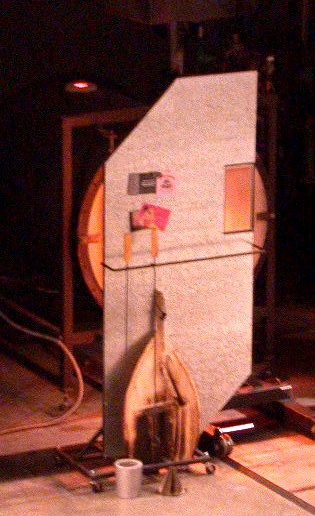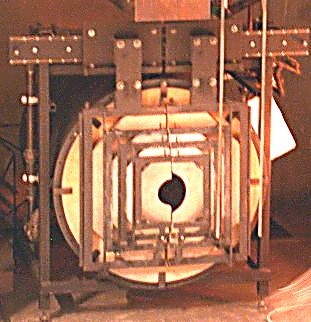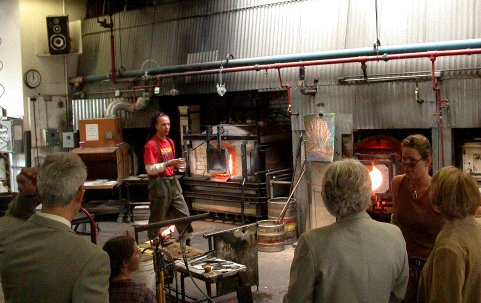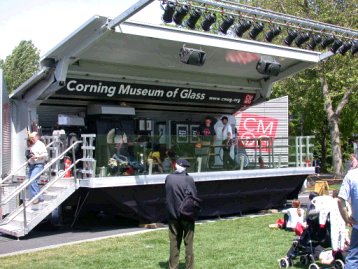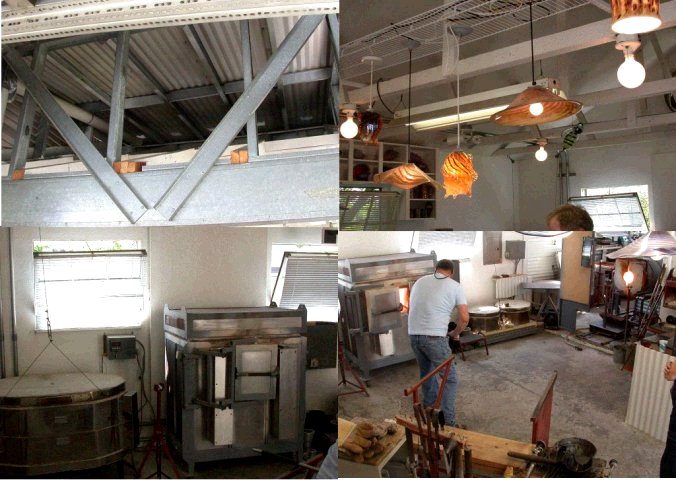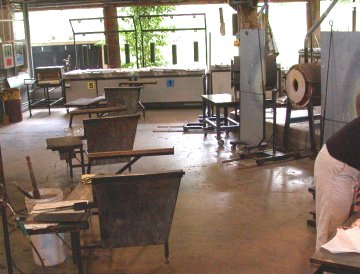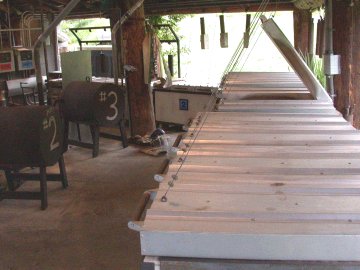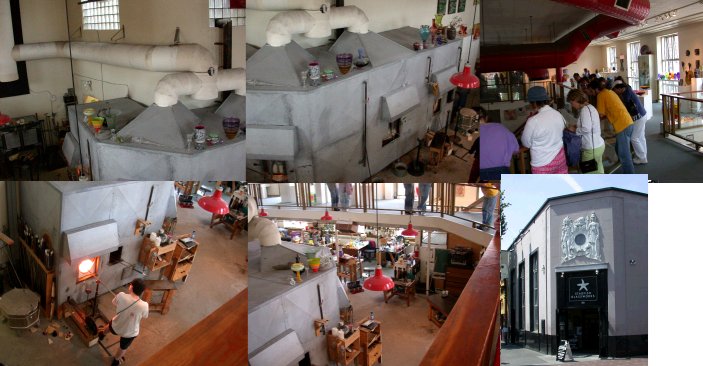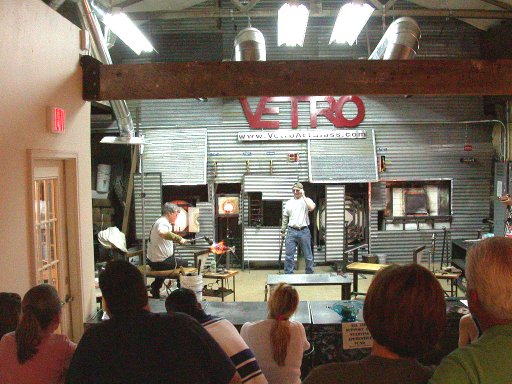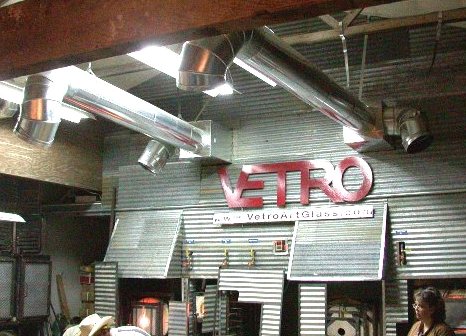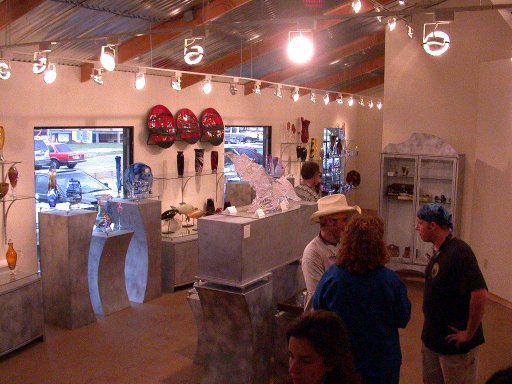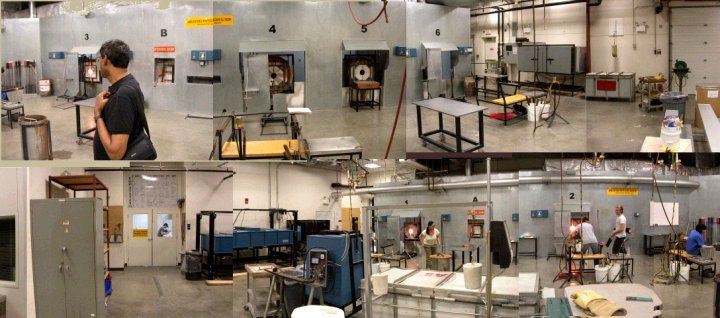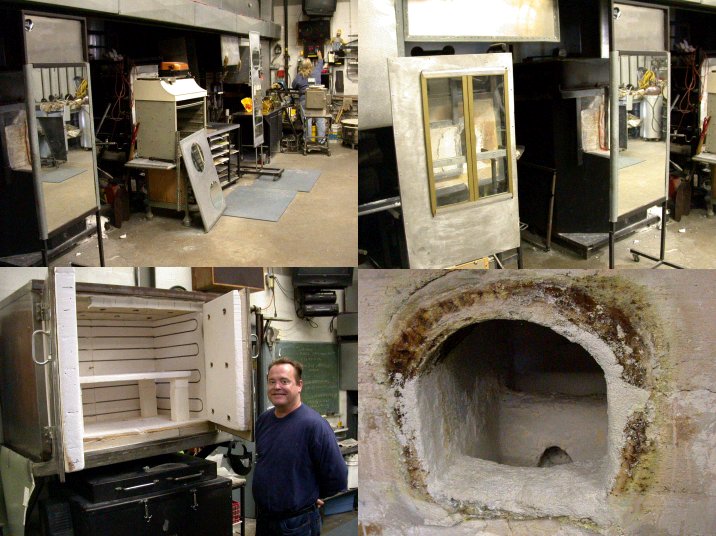|
Tulane University, New Orleans 1994
Zero Gravity Glass, (West of Austin) Texas
This is a very clean setup with no added ventilation. This is in Texas, so the high ceiling, windows above those shown and two large door openings take care of air flow. Like most Texas studios, she shuts down for the summer. The glory hole with the hot opening appears in both pictures. The exhaust pipe running out the window is for fuming and dusting pieces. A marver is just visible left. Notice the two identical rigs on the large and small glory holes for one handed opening of two doors and the huge encasement (with insulation) of the furnace. [Image 1998] Top 1998 setup of Grapevine Art Glass, now changed,
Desert Fire Glass 97 (S. of Tucson)
Almost nothing shows, very quiet. Moveable marver center front. Because of frequent power failures in this location in a freeway side arts village halfway from Tucson to the border, the site has a rapid start backup generator and UPS units. Philabaums, Tucson AZ, behind Lino Tagliapietra (GAS 97) Philabaums is a full fledged working studio
that was the site of the demos for the 1997 Glass Art Society
Conference Peter Andres, of NY state, at Scarborough Faire, TX in a setup not being used by him any more [as of 2000, then being used in 2002] An open pavilion in Old English style, thus the clothes. Two furnaces, one for color, and a gloryhole. Modern pipes at right, wooden bench, annealer somewhat concealed, propane tank in the woods out back. The Faire also has several lampworkers. Andres was doing three renaissance fairs at one point, TX, AZ and NY. Scarborough runs weekends through May into June. Page with more photos Allison Glass Works, Pottsboro, TX (now closed)
Art's facility (also shown here) is almost unique in that his furnace used no electric power. With rather irregular power delivery in his extremely rural location, rather than relying on generators or other backup, he used high pressure propane and a venturi burner with no safety cut-off or thermostat controls. He said he thought he might come back and find it burned down some day. The building stood a long distance from the propane tank and the only building within a quarter of a mile was his gallery space about 100 yards away. The gloryhole did use a blower but was never left on. In summer he was the largest user of propane in the county. 2012-10-03 Hickory Street Hot Glass, Dallas, TX, 2000
This furnace has a pneumatic door, too slow for my taste, and has a glory hole to the left and pipe heater to the right, shown below. Visible along the wall is a 4" white PVC pipe from a blower to the far right that is encased for silence. The pipe heater has its own small blower. For a long time this place had an exhaust fan in the window behind the furnace that was not framed out, so much of the air it circulated went around the blade tips and was not sucking from the room. The studio is located in the basement of a concrete beam and floor, brick filled wall, building used by an oil company for decades as a warehouse. Upper floors have various gallery spaces and living quarters unrelated to the glass. Top
The Hickory Street glory hole which uses a
rectangular burner. It is quieter and produces an even heat
without the torch effect that many workers use. This burner is
mounted on the centerline so it does not swirl the gases as some
are arranged to do. The multiple bends in the gas/air pipe
relieve stress with temperature changes and allow routing the
pipe from the welded housing of the burner to the mixer in back.
Hickory Street Pipe Warmer, the temperature varies across the hole, hotter at the left, but other warmers have different patterns of heat, some trapping heat furthest from the burner. A pipe and five punties are a common layout for the multiple color pieces done here. Leaving a pipe or punty at red heat for long periods is not good for it. The temperature that various people choose for their pipes varies from a very dull red to a bright red. [Facility now closed, equipment moved 2005] Toledo Museum of Art, 1993, Lino Tagliapietra
The modern art glass movement is considered to have started in the early 60's with a meeting that became the Glass Art Society. That first session involved people building equipment from scratch in what was then the garage of the museum. This is a much more modern setup being used at the 30th anniversary meeting. Another furnace to the left of the picture is supplying the glass being used. Note the cutoff valves in the pipe above the units. [And this setup has been totally replaced with a pair of modern glass studios in the new structure. http://www.toledomuseum.org/Visit_GlassPavilion.htm 2008-04-28] Top Galveston Hot Glass A small operation using a lot of millefiori cane (see below). Two small glory holes and a very large annealer (off to right) used also to slump glass panels for cabinet fronts and other curved glass applications. Not quite visible to the left of the white box center left are two color furnaces, shown below. Note the slope of the marver, shown below.
The two kilns are used for melting color in three crucibles each. The color is color bar melted directly. The white box to the right is a small annealer, being used a color pickup marver at the time of the picture.
Although not instantly noticeable in the picture, this marver has a sloping panel attached so that the glass is worked horizontally but takes on a cone shape, where tilting the pipe up or down would tend to move the glass in the shape. This pre-shapes the glass for the optics.
Bowling Green State University, OH 1993
The front view below shows two of the glory holes
and a small furnace, with three different kinds of doors. The
door to the right, for a large arched gloryhole is a pair of
equal weight balanced panels with a V edge on each, forming a
diamond shaped hole as they open. A motor drives the chain that
connects the doors and the controls sit on the floor. The builder
sent me an e-mail to correct my impression that the hole was
square and mentioned the motor was very slow.
Harvey Littleton, Wisconsin (I think) This is an historic hot wall, being that of Harvey Littleton, one of the founders of the modern studio art glass movement. It is from his book, Glassblowing, a Search for Form. Note that all the furnaces are small tank furnaces, built up of unmortared firebrick held together with steel frames. Note also the lack of insulation; a tank furnace must leak heat so the glass is chilled before it gets through all the cracks, freezing and sealing the tank. To the right a frax lined gloryhole and an annealer.
GAS (Glass Art Society) 95 Conference was held in the area of Asheville NC, including a visit to Penland School. A large number of studios in the Penland/Asheville area were open for visits and I was in place early (before they opened) and took a big chunk of the day hitting them (and driving back country roads.) The purpose of these photos is to sample a few hot walls and there is a separate page with more on the conferences. Narrative This is the new hot wall at Penland, just barely opened on time for most of the 1500 participants to show up. The two pictures show the wall with two furnaces, gloryhole and garage and across the room giving some idea of the space in front of the wall - large. Note the bench with a large amount of adjustment for height and angle. I have some pictures of this space filled with several hundred people, plus workers, full to the gills.
Honestly, I don't recall which studio this was at. I will try and figure it out from the order of the images on the negatives and my narrative. A tank furnace built in a surplus stainless pot of some kind, small work space.
This studio, visited late in the day, is on the second floor of a building that was a store. Note wood posts.
This is a place I have not visited, but it is an example of a small home setup, rather well photographed. Click on the link above to visit, back arrow to come back here
Fire Island Art Glass, Austin TX
|
||||
|
Ron told me that the building had been occupied by a company that used the rear to build prototypes of pizza ovens, etc., which were demonstrated in a show room with offices in the front, so it has lots of power and gas. The space is equipped with a pair of swamp coolers that have to be replumbed (left). (Click on pictures to enlarge.) The ventilation hoods of the demo room were moved to the back over the hot wall (center) The glory hole, furnace and pipe heater were moved from the Hickory Street site while the 4" OD smaller gloryhole (with thicker insulation so much smaller inside) is under construction. A full garage door off left gives access. The hanging lights and skylights give the space a bright feel The gallery is off right. [Since moved.] |
||||
[Click on each image section to
enlarge]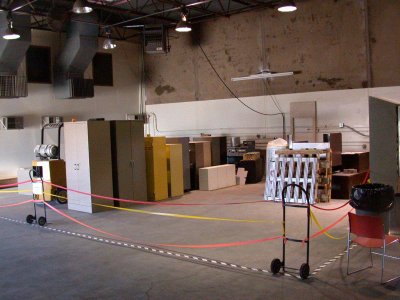 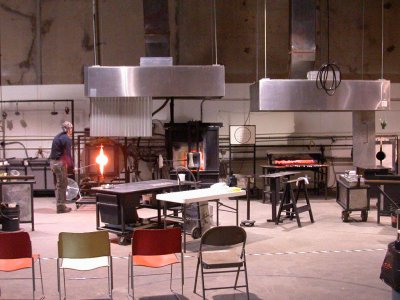 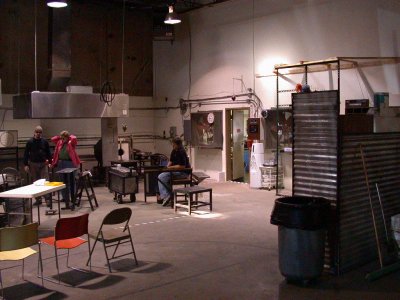 |
||||
|
The studio has considerable extra available space (behind the camera in this view) and is laid out along one wall in this panorama The equipment is newly built, it seems, and the ribbon burner glory hole was having trouble keeping hot with the doors partly open. For the demo, two glory holes were lighted, hardly a common practice, the pieces of equipment from right below are small glory hole, annealer, furnace and large glory hole. There are two nice benches (right and center rear) and a couple of marvers (but the double image in the foreground is due to camera angle changes in making the panorama.) The space is not as bright as the image suggests, lighted by half a dozen single 8' fluorescent fixtures without reflectors. Some suggestion of the contrast is the brightness of the glare from the skylight center rear and this is late afternoon (5pm) December lighting with the sun shining low on the front of the building. [since closed) |
||||
|
|
||||
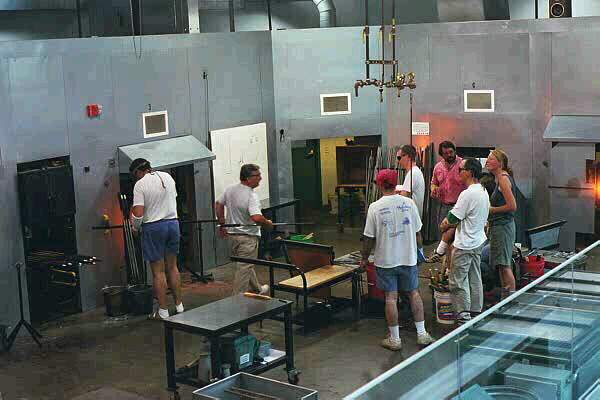
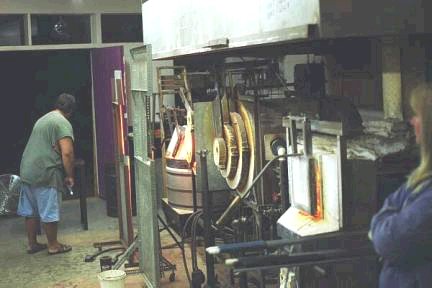

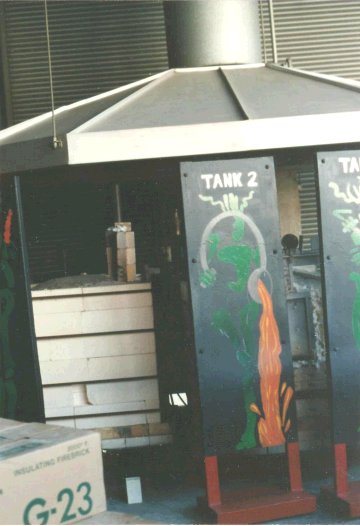

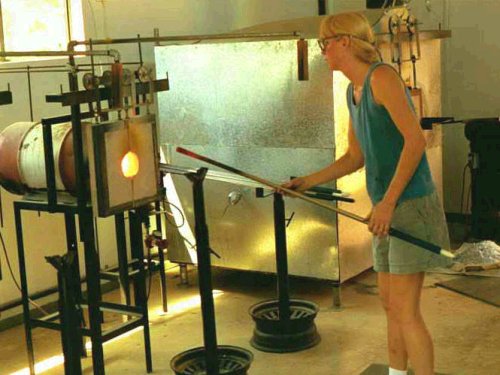
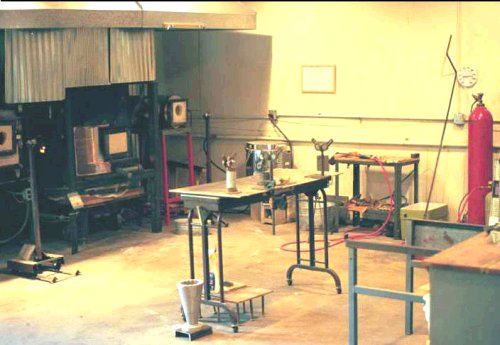
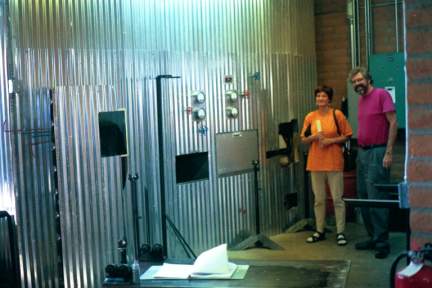
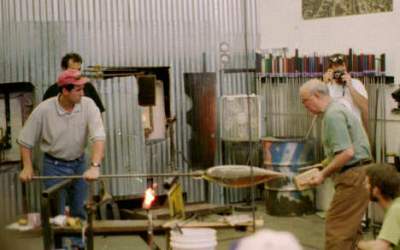

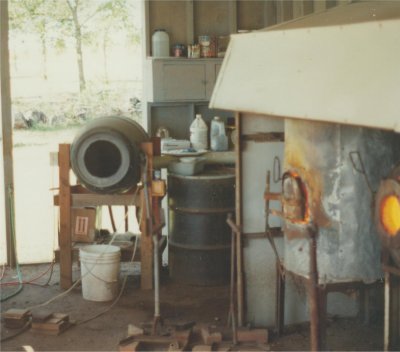
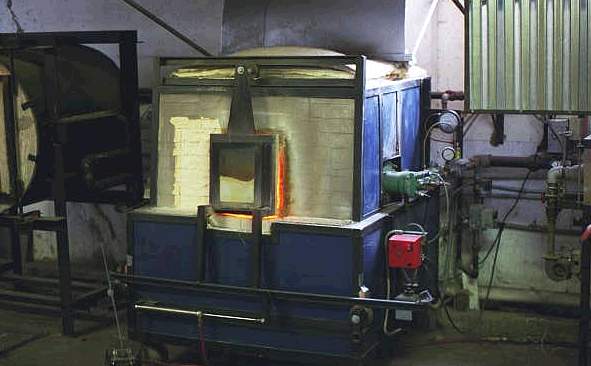
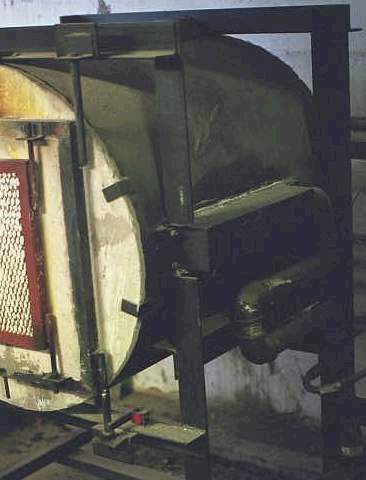
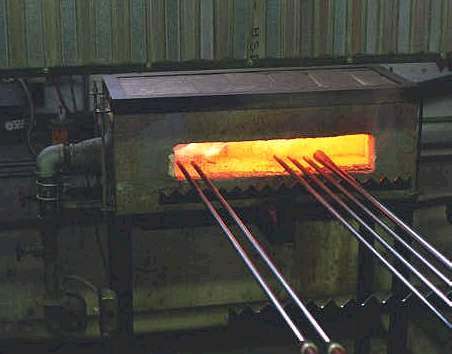
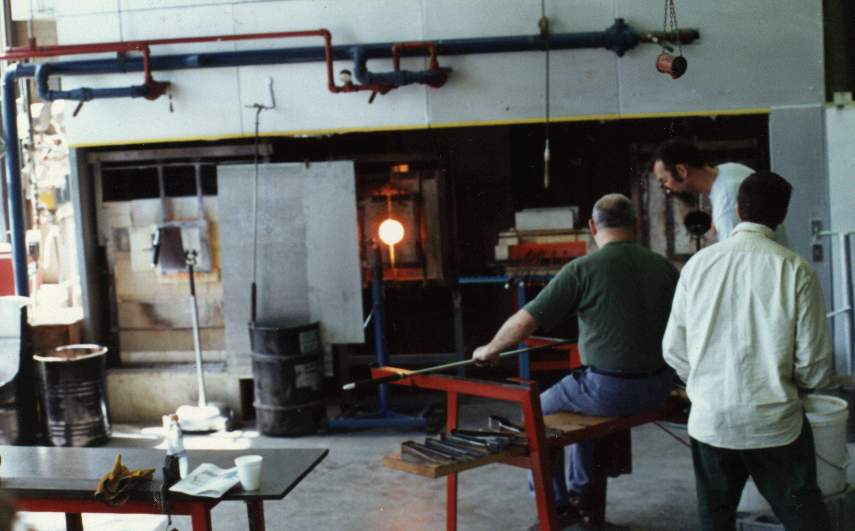
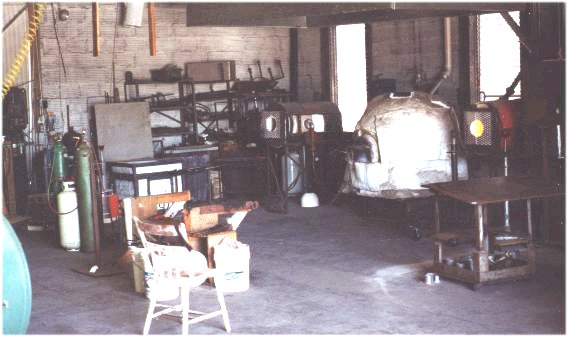
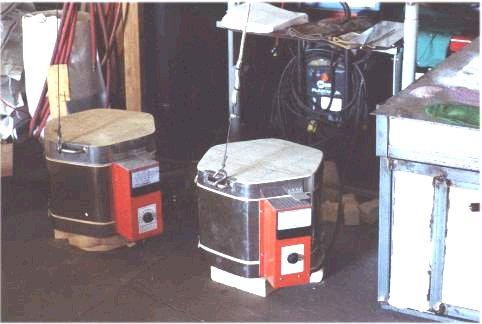
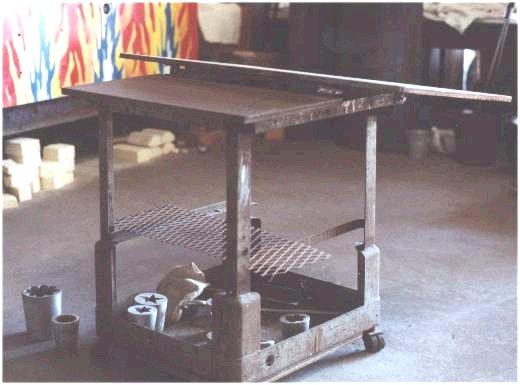
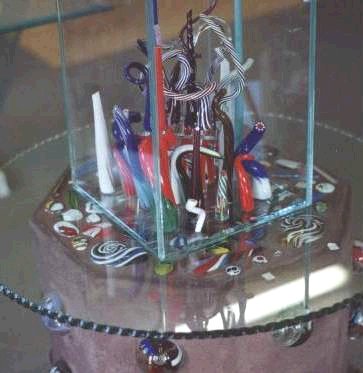
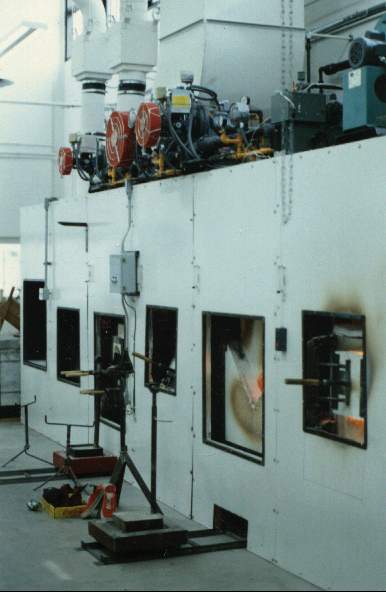
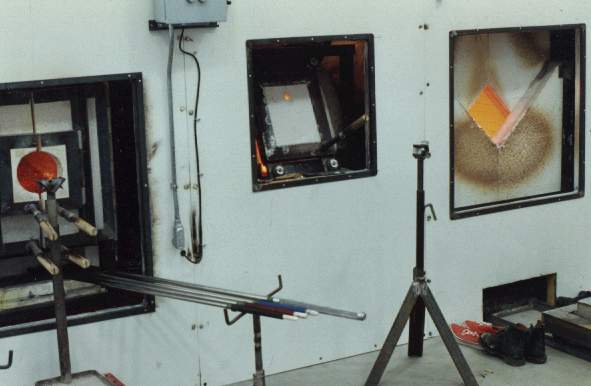

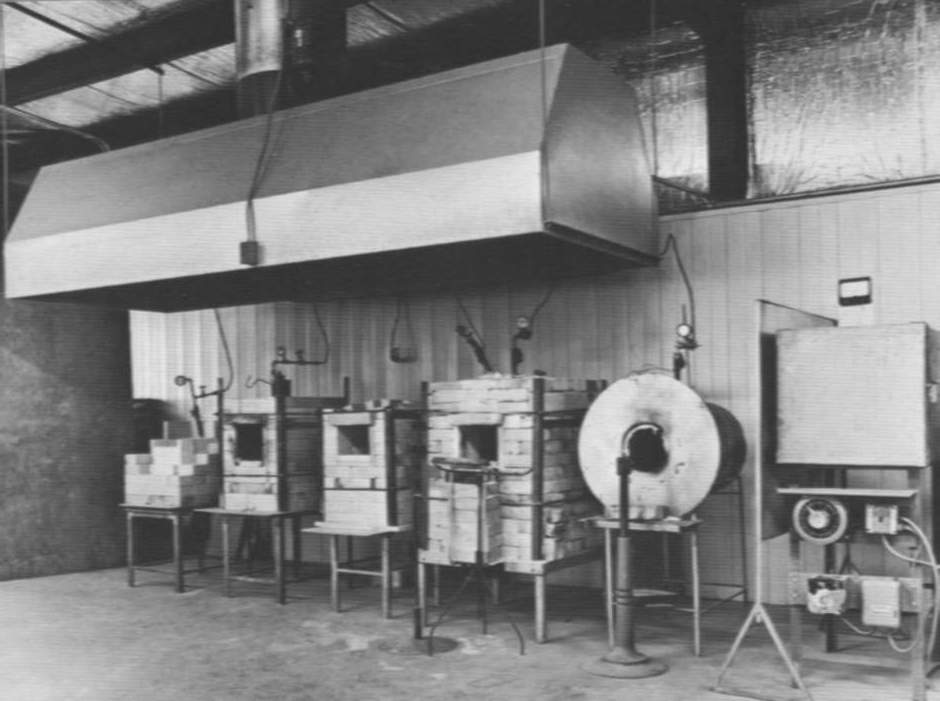

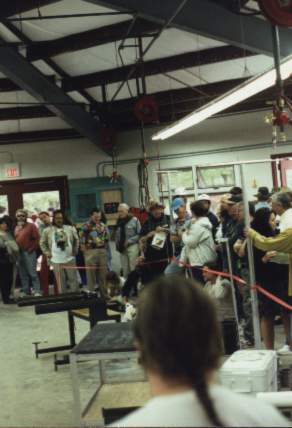
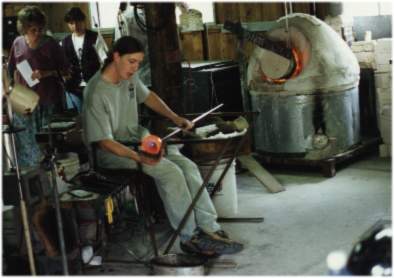
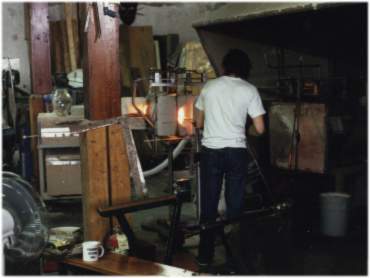

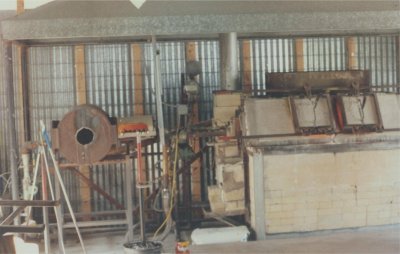 Certainly
one of more unusual hot walls, including a smaller gloryhole off to right.
The large box shape is the glass furnace which is highly insulated but is just a
big empty box with gas fired heat. The two angled doors roll to either
side and the openings look right down into free standing pots. The left
door is over a substantial pot of clear and the right gives access to 3 or 4
cylindrical and smaller color pots. One of the products of Fire Island
(now closed) was "Cave Weights" which were a clear core with applied color
pushed in then the whole cased in opaque black and a side ground away to form a
window into the interior cave.
Certainly
one of more unusual hot walls, including a smaller gloryhole off to right.
The large box shape is the glass furnace which is highly insulated but is just a
big empty box with gas fired heat. The two angled doors roll to either
side and the openings look right down into free standing pots. The left
door is over a substantial pot of clear and the right gives access to 3 or 4
cylindrical and smaller color pots. One of the products of Fire Island
(now closed) was "Cave Weights" which were a clear core with applied color
pushed in then the whole cased in opaque black and a side ground away to form a
window into the interior cave. 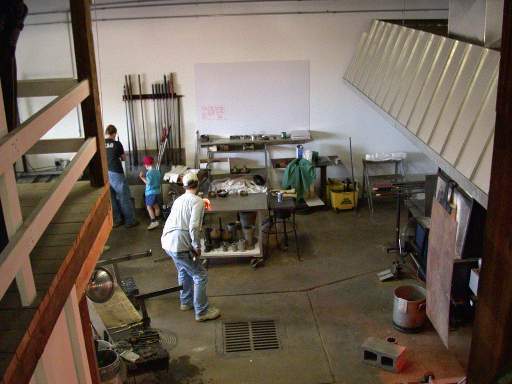 Jim Bowman's new shop has enormous
working space of which this is just the overhead view from the
gallery/coldshop/stained glass area into the hot shop. The hot
wall is to the right and the outside access doors to the left.
The rails on the left edge of the picture are around a viewing
platform that overhangs the space and there is more viewing along
a rail to the right of the photograph. At the time this picture
was taken, it was newly set up having only an elaborate hood with
a rail inside to shuttle a blocking metal shield across the space.
Viewed in April 2002.
Jim Bowman's new shop has enormous
working space of which this is just the overhead view from the
gallery/coldshop/stained glass area into the hot shop. The hot
wall is to the right and the outside access doors to the left.
The rails on the left edge of the picture are around a viewing
platform that overhangs the space and there is more viewing along
a rail to the right of the photograph. At the time this picture
was taken, it was newly set up having only an elaborate hood with
a rail inside to shuttle a blocking metal shield across the space.
Viewed in April 2002.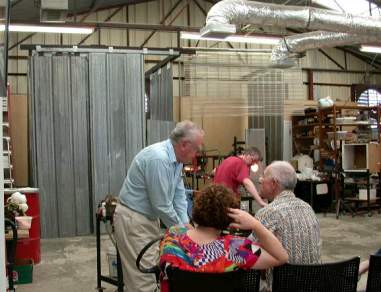 This is the studio of Dick Moiel and his
wife Kathy Poeppel and many more shots are shown
This is the studio of Dick Moiel and his
wife Kathy Poeppel and many more shots are shown 
